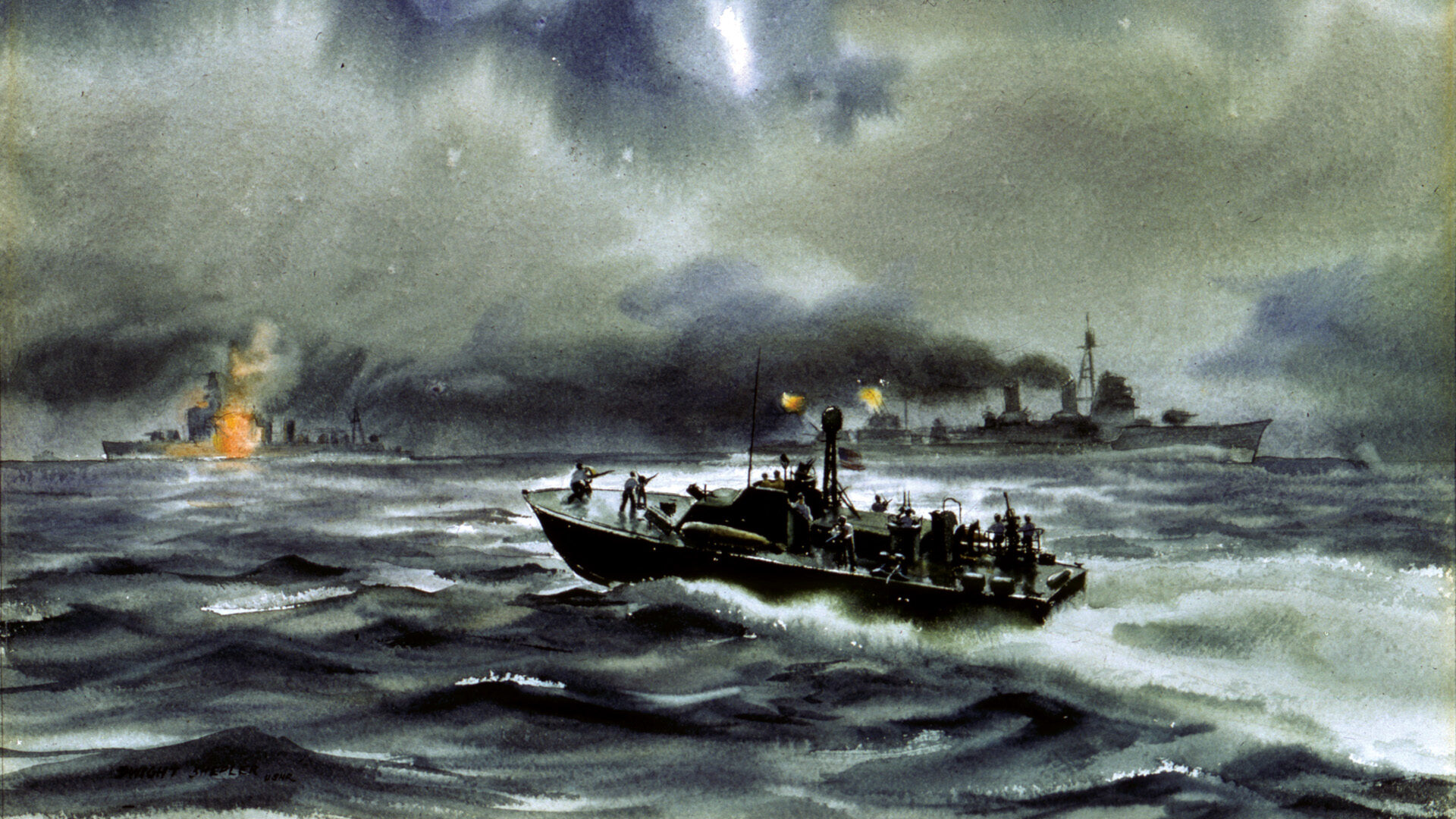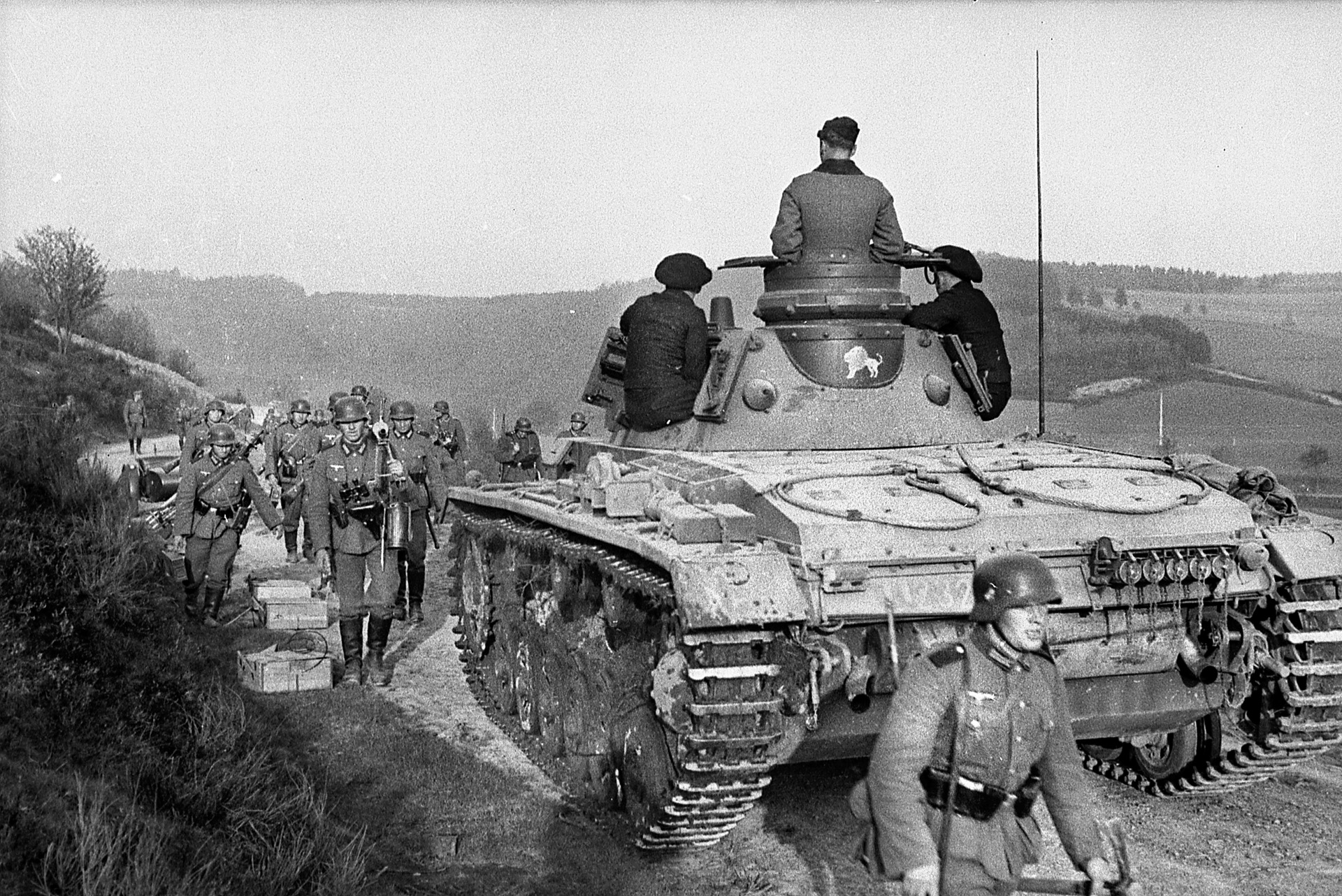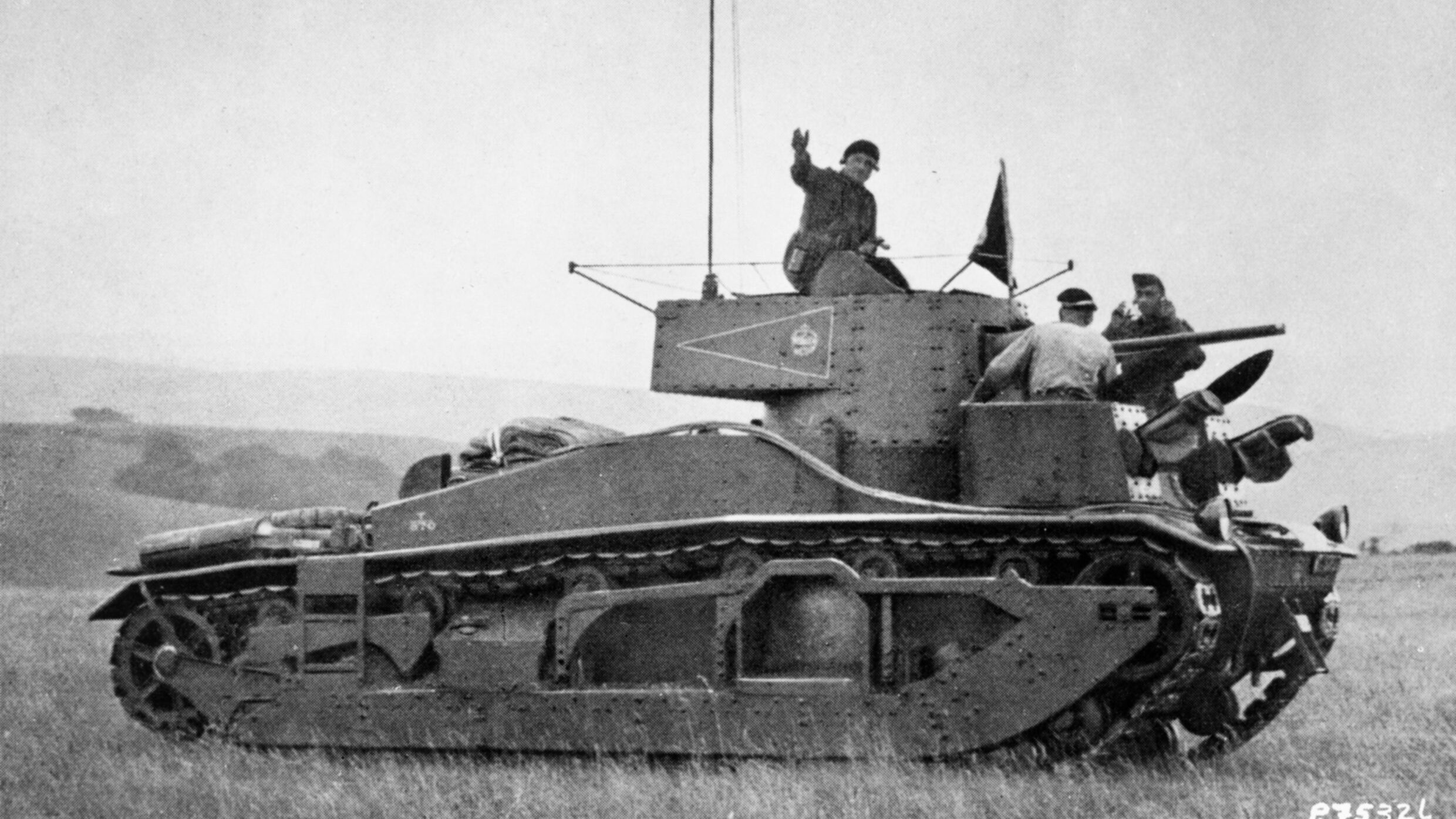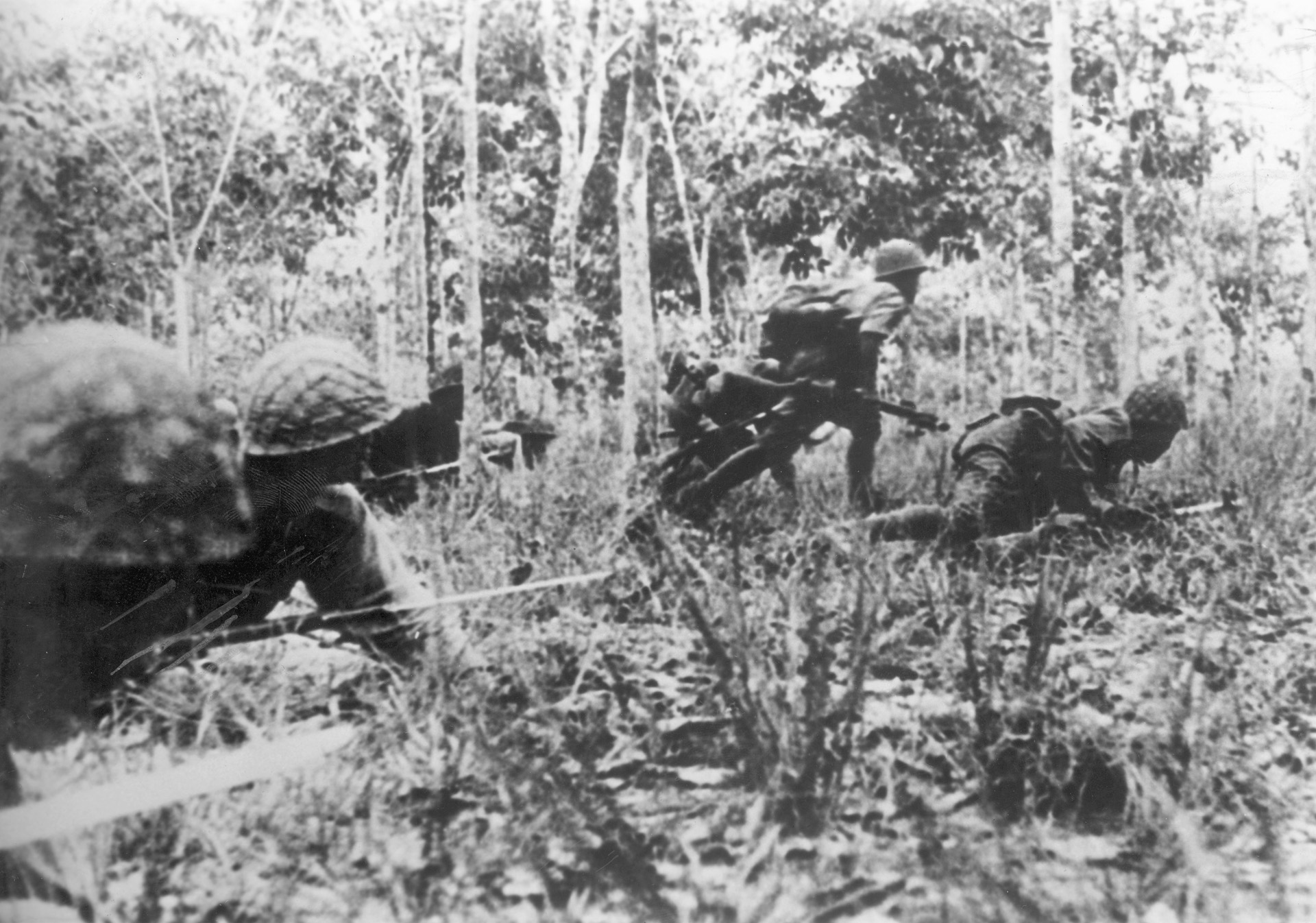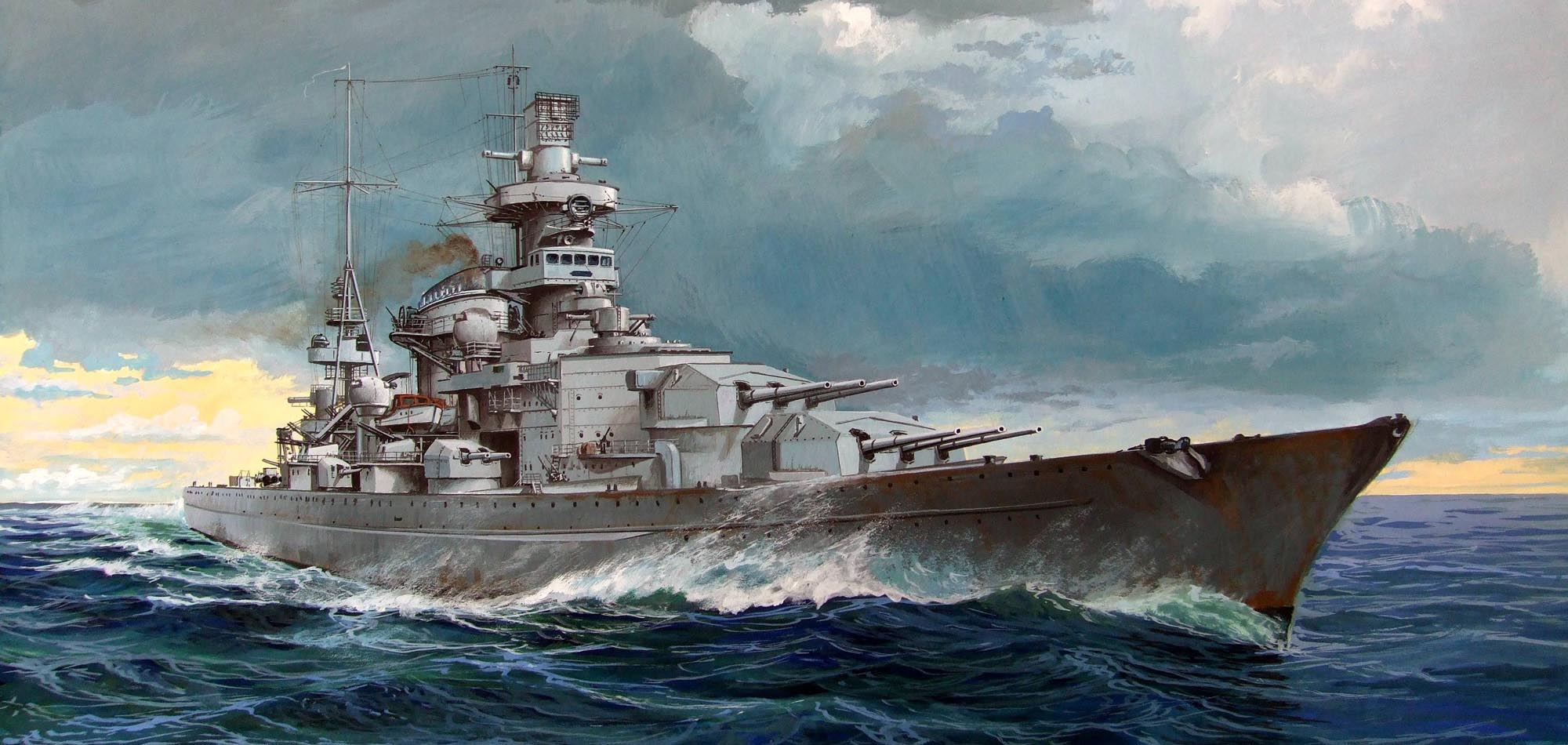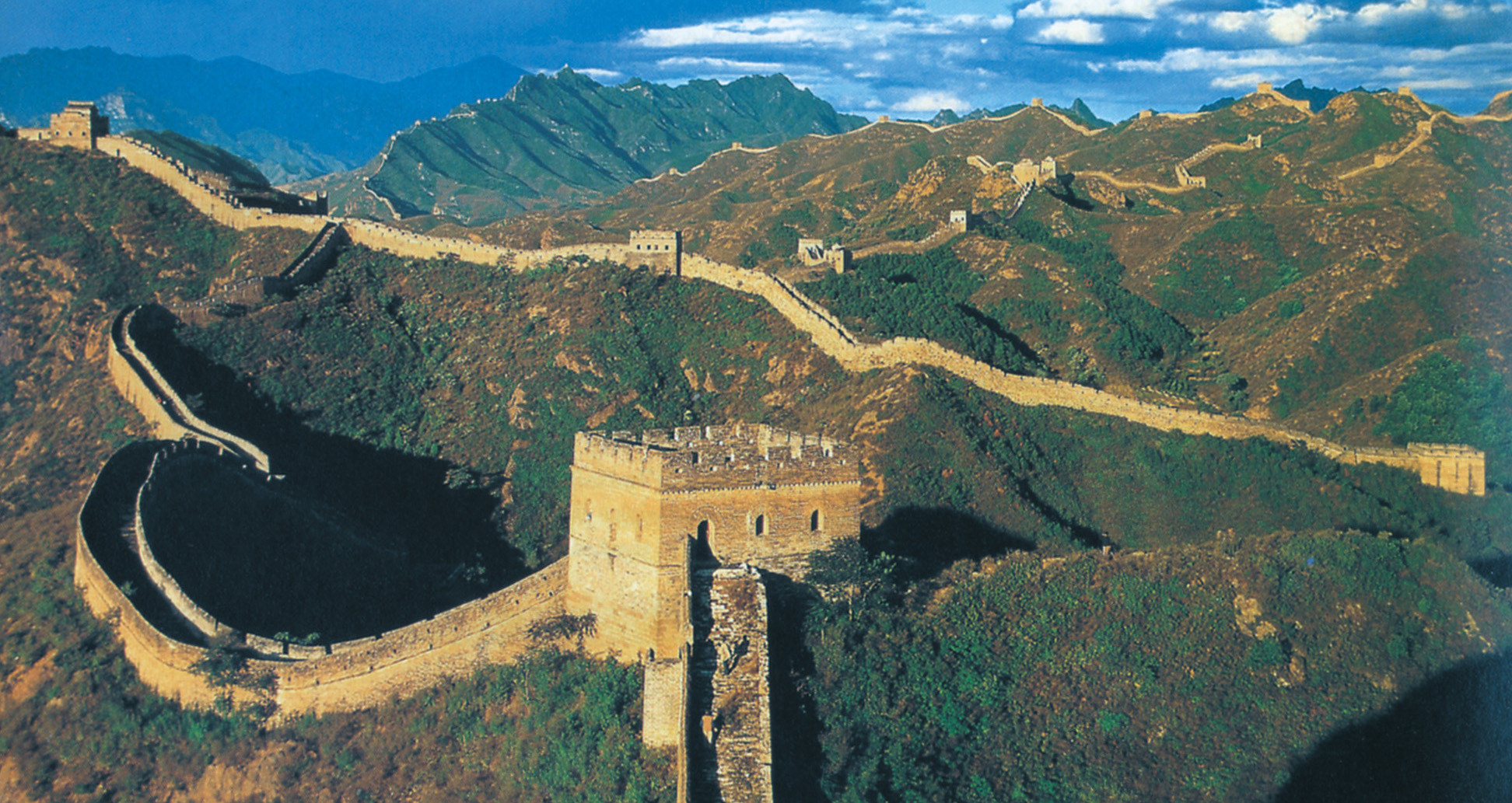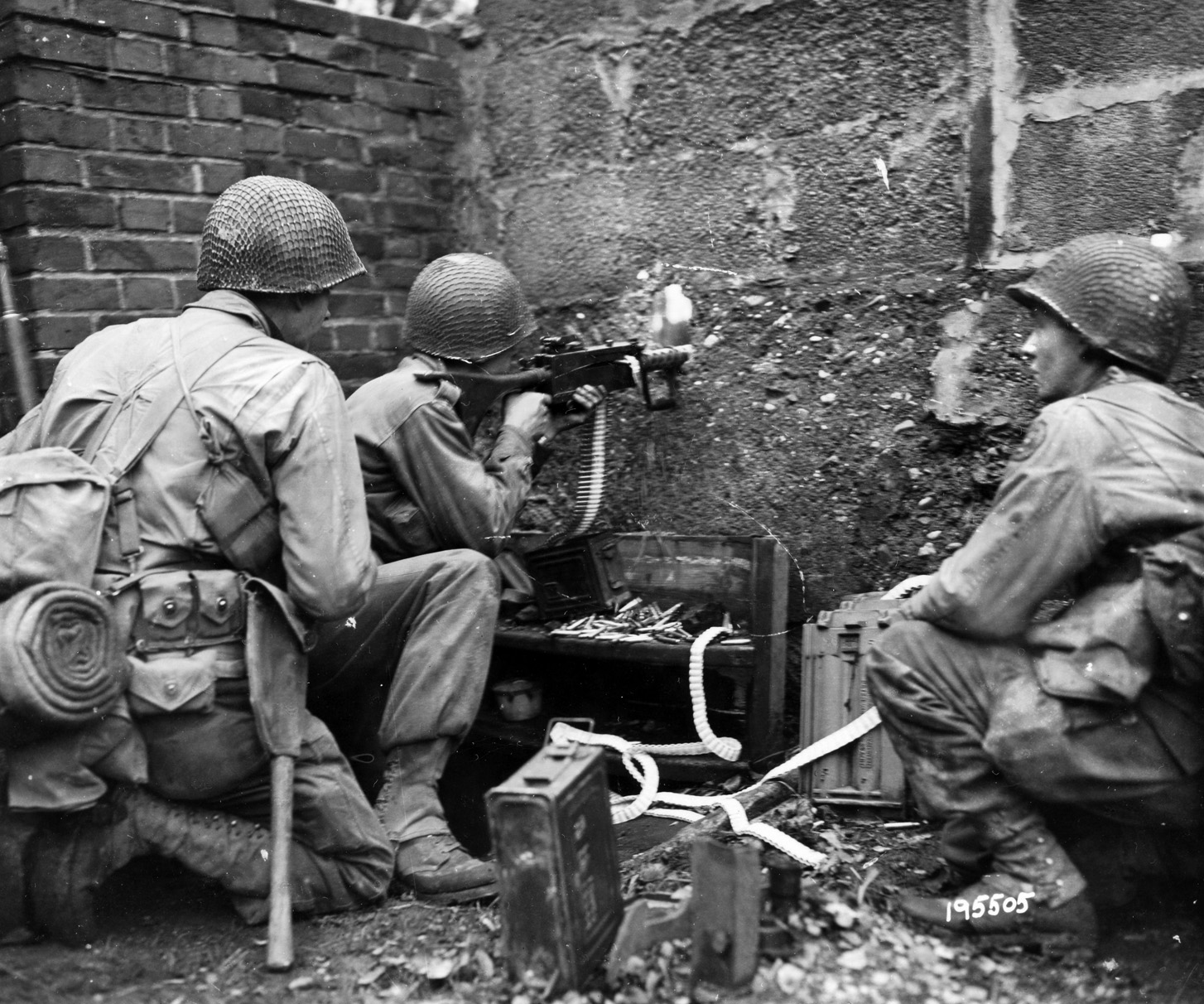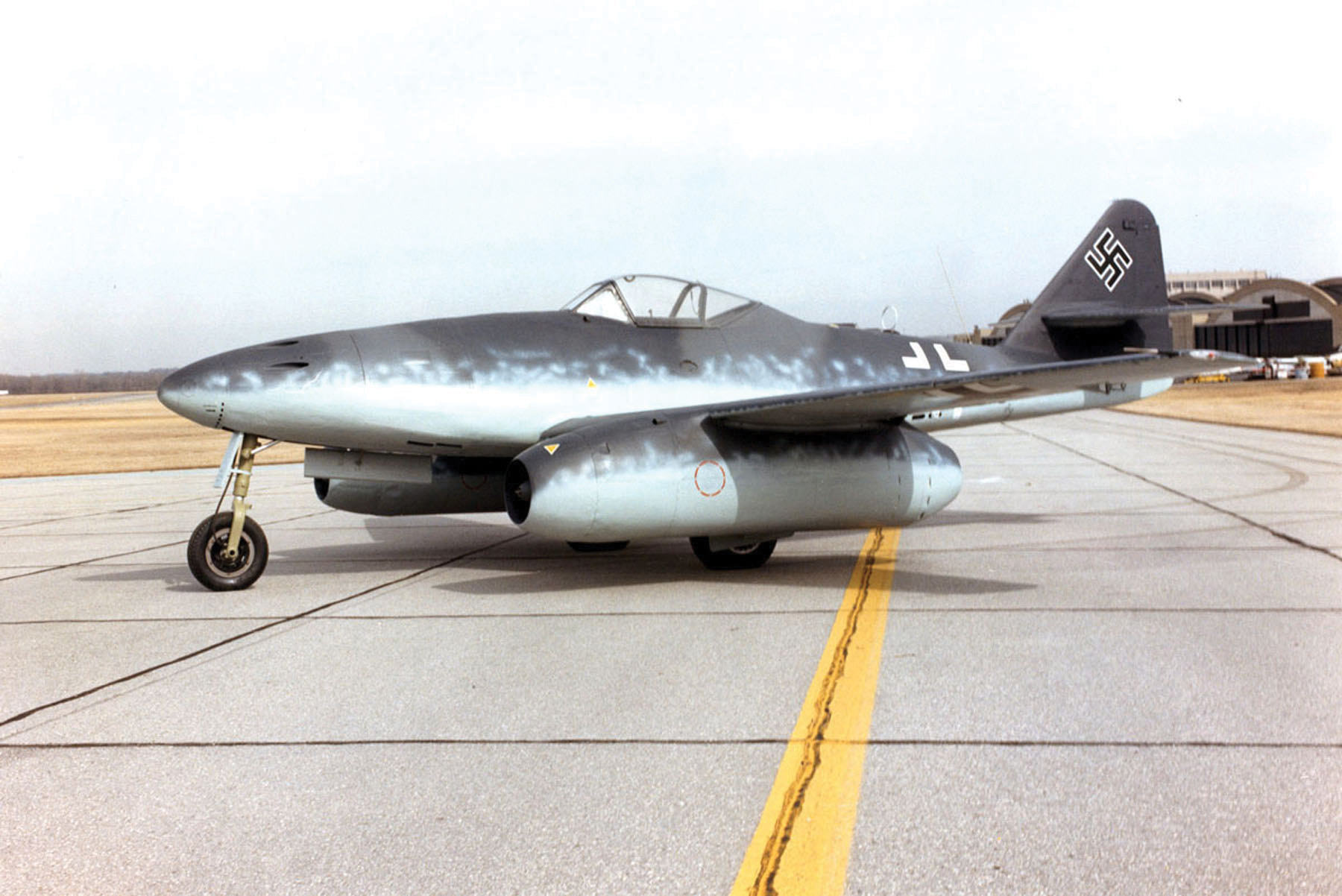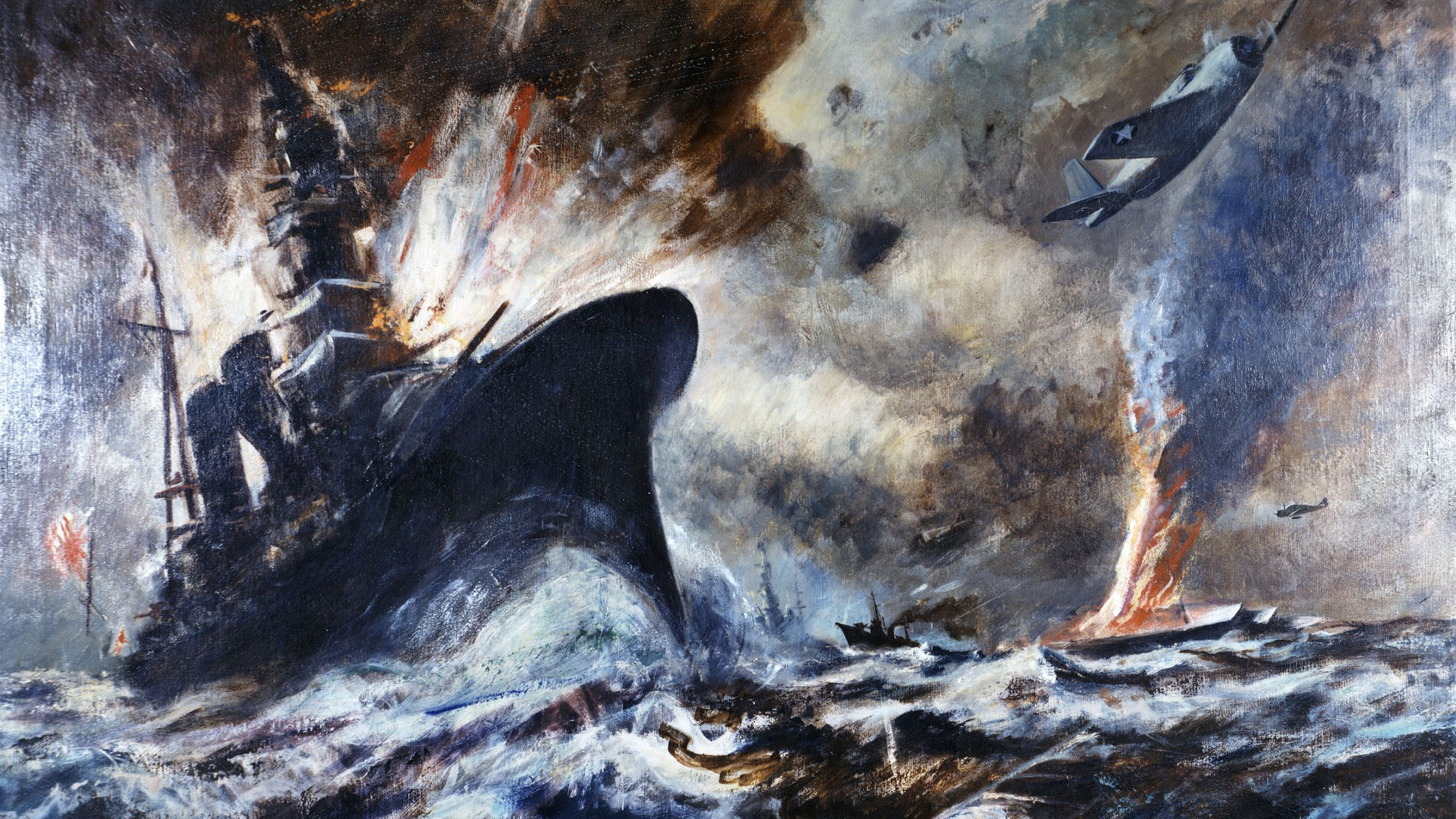By William F. Floyd, Jr.
Late in the day on October 24, 1944, all of the available 39 patrol torpedo (PT) boats of the U.S. Seventh Fleet were traveling at high speed into the Mindanao Sea just south of Leyte Gulf. By dusk they had taken up position in a patrol line. The journey of the boats from New Guinea to Leyte Gulf, which was approximately 1,200 miles, presented a difficult problem for the U.S. Navy. The distance was considered too far for the boats to complete in one hop, even if they were escorted by tender, so the Navy set to work to devise a more viable plan.
The Navy decided to have the PTs fueled from the tenders. As for the tenders themselves, they would be fueled by tankers. The journey of the boats would represent the largest movement of PTs under their own power during the war. The U.S. Navy’s ship commanders in the Philippines depended on the PT boats at Leyte for an advance warning of the approach of the Japanese fleet.
The PT boats’ first contact with the Japanese Imperial Navy in the unfolding Battle of the Leyte Gulf was an encounter with a group of battleships. Ensign Peter Gadd, who operated the radar aboard PT-131, picked up the battleships on radar at 10:36 pm. Three PT boats began closing on the target to make their attack. The Japanese battleship crews soon sighted the PT boats and began firing on them. The PT boats radioed their sighting to Rear Admiral Jesse Oldendorf, commander of Task Group 77.2 that was guarding the Surigao Strait. The PTs made repeated attacks over three hours but were unable to score any hits. Unable to thwart the Japanese battleships, the PT boats retired and the next day U.S. destroyers moved in to engage them. The incident shows the critical role that PT boats performed in the Pacific Theater to screen U.S. bases and warn U.S. fleets of threats.
When World War II began, the small craft that came to be known as the PT boat was less than 40 years old. The origins of the PT boat can be traced back to the American Civil War. In 1864 Confederate Captain Hunter Davidson developed a forerunner of the PT boat when he fixed an explosive charge to the end of a long pole that jutted out from the bow of a small rowing boat. The spar torpedo proved highly effective; however, by being so close to the explosion, the crew of the attacking vessel was in danger of being blown up as well. What was needed was a self-propelled torpedo.
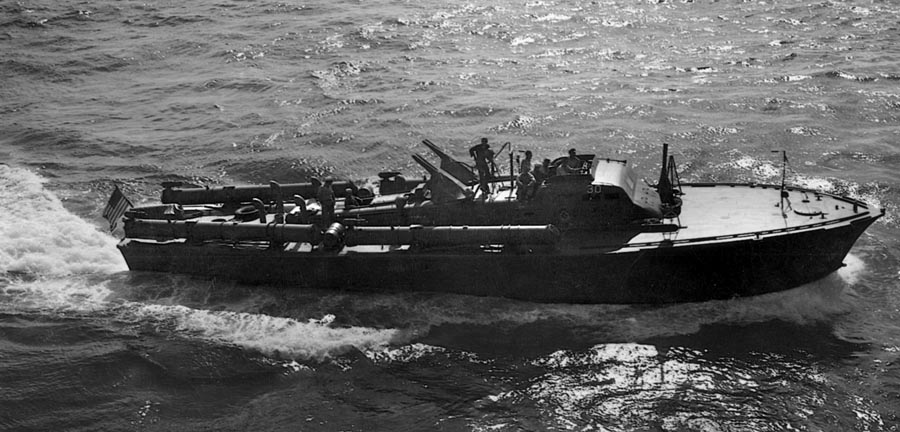
In 1866 English inventor Robert Whitehead developed just such a torpedo. Whitehead’s self-propelled torpedo was designed to strike a vessel below the water line. It revolutionized small boat tactics. Six years later the British Alfred Yarrow shipyard began experimenting with spar torpedoes that naval engineers mounted on the bow of a 30-foot steam launch. The combination of a self-propelled torpedo and a power-driven boat became of great interest to both major and minor naval powers and they clamored for torpedo boats. Small navies in particular saw them as a way to offset the threat posed by large warships.
The PT boat fully matured during World War I. PT boats made during World War I were powered by steam. But steam engines eventually gave way to small internal combustion engines that offered faster speed and were less expensive to produce.
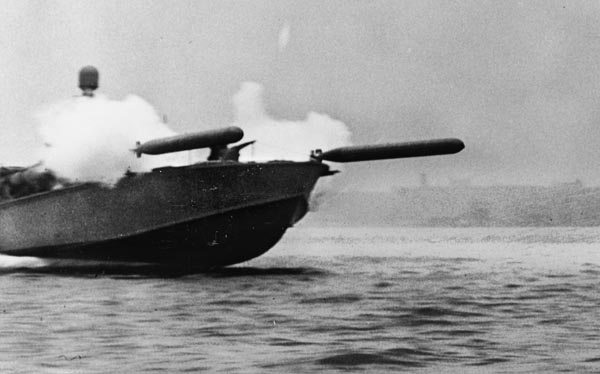
The U.S. Navy had little interest during that conflict in PT boats, but by 1938 it became interested in developing them. Discussions between Assistant Secretary of the Navy Charles Edison and Henry R. Sutphen, executive vice-president of the Electric Launch Company (Elco), led to the signing of a contract in 1941 whereby Sutphen’s company would furnish the U.S. Navy with PT boats.
In 1939 Edison had informed the General Board of the U.S. Navy, an advisory council composed of senior admirals, that a 70-foot motor torpedo boat was available in Great Britain. British boat designer Hubert Scott-Paine was the brains behind the motor torpedo boat. The General Board advised Edison that the boat should be obtained as a check against the U.S. Navy’s continuing development and refinement of its PT boats.
After further conferences with the Navy, Stuphen traveled to England to buy the boat with his own money. His understanding was that if he bought the Scott-Paine boat, the Navy would purchase it. A deal eventually was struck whereby the British Power Boat Company sold its private venture motor torpedo boat to the U.S. Navy.
Production of the Scott-Paine boat, which was designated PT-9, began in New York on September 5, 1939. The U.S. Navy subsequently awarded a contract to Elco on December 7 for 11 motor torpedo boats and 12 motor boat submarine chasers. The only major revision from the Scott-Paine model was the use of a Packard engine in lieu of one from Rolls Royce.
The U.S. Navy used the Packard V-12 Marine Engine (4M-2500) in all U.S. Navy World War II PT boats. The design was based on the 1925 Liberty Aircraft Engine, which had been converted for use in racing. Throughout the war the Packard engine underwent a number of key updates and modifications. The Navy steadily increased the horsepower from 1,100hp to 1,500hp so that the PT boats could maintain high speed as increasingly heavier armament was added to them. The final engine was a super-charged, water-cooled, gasoline-powered V-12 engine that weighed 2,900 pounds. With a full fuel load, the PT boat had a range of 259 miles at 35 knots, which amounted to a total of 518 miles.
Shortly after the United States entered World War II as many as a dozen manufacturers at home and abroad competed to furnish PT boats for the U.S. Navy. Two boat builders eventually dominated the field: Elco of Bayonne, New Jersey, and Higgins of New Orleans. The principal PT was Elco’s 80-foot-long boat. Higgins’ boat measured 78.5 feet in length. By the end of the war, Elco had built 399 boats and Higgins had constructed 200. A third manufacturer, Huckens of Jacksonville, Florida, built just 18 boats. The Navy did not use the Huckens boats in combat, however.
The Elco PTs served mainly in the Pacific; however, a small number also were used in the English Channel and the Mediterranean Sea. As for the Higgins PTs, half of them went into service in the European Theater and the other half in the Pacific Theater. As for the Huckens PT boats, the U.S. Navy designated those for use by the PT boat training squadron in Melville, Rhode Island, as well as to the Panama Canal Zone and the Hawaiian Islands.
PT boats constituted a unique class of fighting ship. They were intended to intercept ships of larger classes through firepower and speed. To do this, they were armed with torpedoes, rockets, mortars, and machine guns. Their shallow drafts gave them a distinct advantage over vessels with deep drafts. It enabled them to penetrate minefields and harbor defenses. What is more, they were hard to see on the horizon against the ocean.
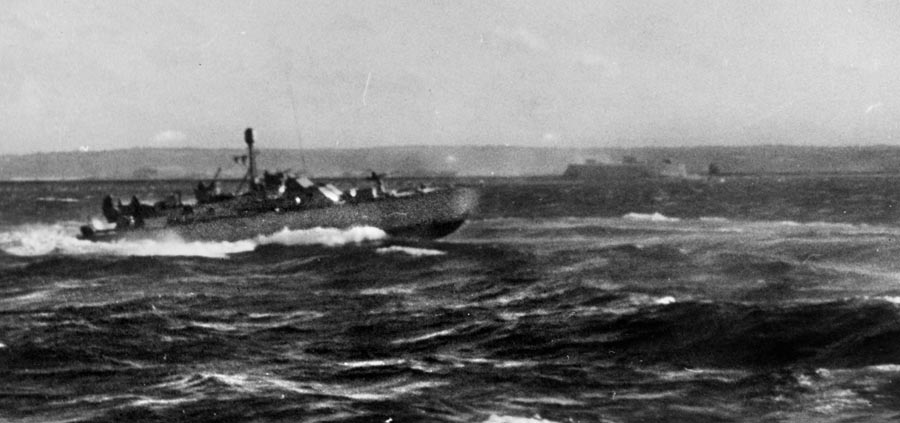
The Imperial Japanese Navy routinely sent ships out at night during this period to deliver personnel, supplies, and equipment to Japanese forces operating in and around New Guinea and the Solomon Islands. The regularity of these runs compelled the Allies to call them the Tokyo Express.
The U.S. Navy deployed Motor Torpedo Boat Squadrons 2, 3, and 6 in Iron Bottom Sound, the stretch of water at the southern end of The Slot between Guadalcanal, Savo Island, and Florida Island in the Solomons, to interdict the Tokyo Express. Night after night the sailors in these PT boat squadrons risked their lives in an effort to disrupt and destroy the Japanese convoys. Harrowing encounters unfolded as PT boats used their torpedoes and other weapons in an attempt to sink Japanese ships and troop-carrying barges.
In addition to their vital service in the Southwest Pacific, PT boats also played a vital role in protecting U.S. bases in the North Pacific, namely, in the Aleutian Islands. The islands stretch nearly 1,000 miles from the mainland into the North Pacific. Attu Island, the westernmost in the chain, is only 650 miles from the northern part of the Japanese-owned Kurile Islands where Japanese forces were based.
On June 3, 1942, the Japanese attacked the U.S. naval base at Dutch Harbor on the island of Unalaska. Three days later the Japanese began landing troops on Attu and Kiska, where U.S. weather stations were located. The U.S. Navy did not have any PT boats stationed in the Aleutians, so it had to transfer them from another location.
Beginning on August 11, 1942, the U.S. Navy began shipping PT boats from Pearl Harbor to Seattle, Washington, for overhaul at the Olson-Winge Marine Works. A key part of the overhaul was the installation of 20mm guns. The overhauled PT boats arrived at Dutch Harbor on Amaknak Island on September 1. It turned out that the PT boats were ill equipped for service in the extreme environment of the Alaskan waters, though. The only heat on PT boats came from the stoves located in the galley, which was a small alcove off the crew’s quarters.
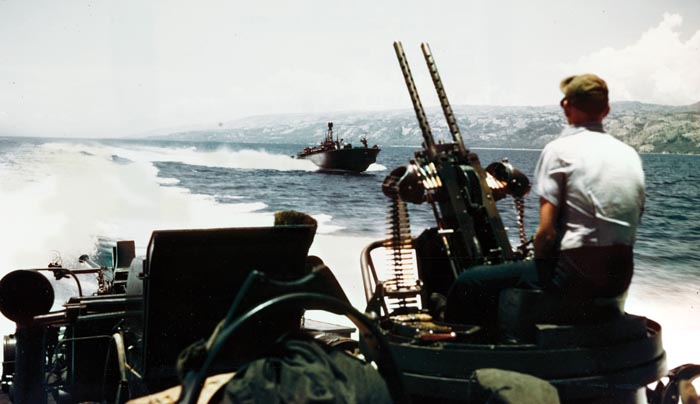
On May 11, 1943, units from 17th Infantry of Maj. Gen. Albert Brown’s 7th U.S. Infantry Division landed on Attu to retake it from Japanese Imperial Army forces led by Colonel Yasuyo Yamasak. PT boats assigned to the mission had orders to protect the amphibious forces from possible enemy counterattacks. The Aleutians Campaign entered its final phase in mid-August when U.S. forces seized Kiska Island. The PTs were part of a feint to mislead the Japanese; however, the U.S. forces found that the Japanese already had abandoned the island. After the campaign, the U.S. Navy returned the PT boats to Seattle.
PT boats were also active in several areas of the European and Mediterranean Theaters. The U.S. Navy shipped a number of PT boats to Great Britain and the Soviet Union through the Lend-Lease program. In the Mediterranean Sea PT boats patrolled the coasts of southern France and northern Italy. The squadrons focused on disrupting and destroying enemy supply ships, particularly German vessels supplying their troops in North Africa. In carrying out this mission, the PTs were opposed by German Navy E-Boats and S-Boats. These vessels were up to 50 percent longer and sleeker than the PTs. Despite their shorter length, the PT boats held their own against the Germans.
PT also were used to support the D-Day invasion on June 6, 1944. The boats harassed shore installations in support of Allied troop landings, destroyed floating mines, rescued downed pilots, and landed partisans behind enemy lines. On the night of May 19-20, the first PT boat crossed the English Channel carrying agents and equipment to the French coast. PT Squadron 2 performed 19 of these missions for the Office of Strategic Services without once being detected by the Germans. These types of operations would continue until the majority of the French coast was in Allied hands. As the war in Europe ended with the German surrender, the PTs began returning to the United States. A number of the PTs were overhauled in anticipation of being sent to the Pacific. But the war ended before this became necessary.
In August 1945 the U.S. Navy had 30 PT boat squadrons still in commission. By year’s end all had been decommissioned except Squadron 4, a training squadron, and Squadron 41, a new squadron. The only squadron to be commissioned after the war was Squadron 42.
The U.S. Navy ended up destroying most of its PT boats because the light wood from which they were made could not be stored for future use as could the steel used in decommissioned warships. Before being scrapped the PT boats were first stripped of their valuable armament.
In the aftermath of World War II the United States and other countries have experimented with missile-carrying, next-generation fast patrol boats. These feature hydrofoils to lessen drag and increase speed. Air-cushioned hovercraft vessels also achieve the same outcome.
Many major powers have experimented with these kinds of vessels, including Great Britain, United States, Russia, Italy, Japan, Germany, and Canada. These next-generation patrol boats, which improve on the design of the World War II-era PT boat and continue that tradition, are an important way to protect coastal waters.
